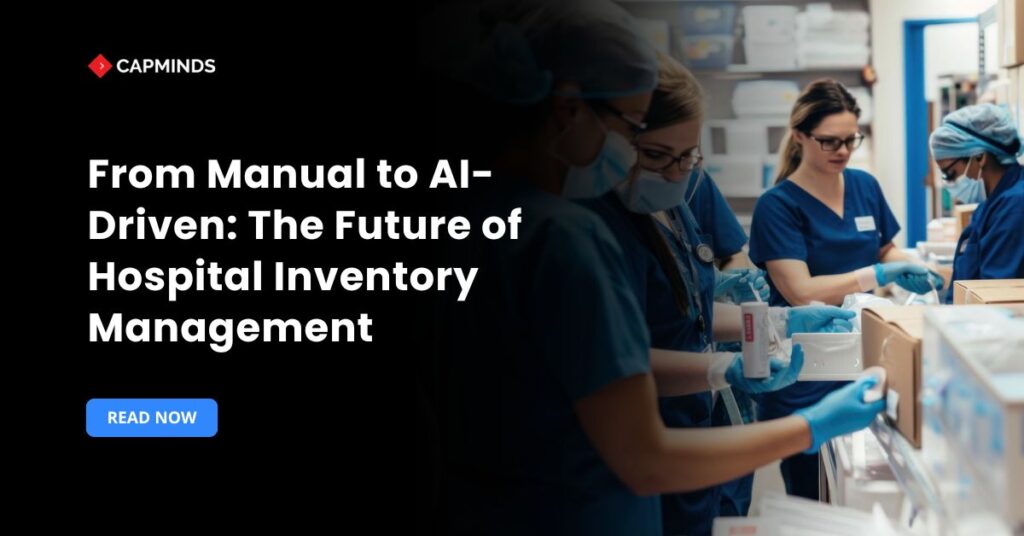From Manual to AI-Driven: The Future of Hospital Inventory Management
Hospitals traditionally rely on manual or legacy systems to track medical and surgical supplies, leading to persistent challenges. Paper-based logs, spreadsheets, and siloed systems mean that stock levels and expiration dates can be inaccurate or out of date. This lack of real-time visibility often causes both overstocking and stockouts, as clinicians scramble to find needed items. In busy environments such as operating rooms or emergency departments, dozens of staff may draw from a common supply room without any centralized tracking.
As a result, manually tracking fluid inventories becomes “virtually impossible” as usage surges and staff rotate shifts. In practice, this can lead to wasted time searching for supplies, unexpected shortages in critical cases, expired or spoiled products, and frustrated staff forced to spend time on clerical tasks rather than patient care.
Hospitals are under growing pressure to control costs and improve efficiency, so these inventory gaps are no longer tolerable. Yet even as health systems recognize the importance of supply chain accuracy, many still lack integrated systems that share data across departments.
Legacy software, disconnected procurement and billing platforms, and manual count sheets create “blind spots” in stock levels and usage patterns. These challenges highlight why many hospitals are now embracing digital transformation in their supply chains.
Rather than simply digitizing paper logs, healthcare providers are adopting new technologies, from cloud software to AI analytics, to make supply management smarter and more proactive.
Digital Transformation in Healthcare Supply Chains
Digital transformation means using technology to streamline every step of the supply chain and inventory process. In practice, this often involves moving to cloud-based inventory and ERP systems that centralize data from procurement, pharmacy, materials management, and clinical departments.
By bringing inventory data into a single digital platform, hospitals gain “enterprise-wide visibility” into supplies and equipment.
- For example, cloud-based systems let staff at different facilities or floors see stock levels in real time, ensuring that an item used in one department automatically updates availability everywhere else.
- This breaks down silos and prevents outdated or duplicate orders.
Automation is another pillar of transformation. Modern systems use barcode or RFID scanners at the point of use, wireless shelf sensors, and mobile apps to automate data collection. Instead of manually logging each supply issue, a clinician might simply scan an item when withdrawing it.
The system then logs the transaction automatically, updating inventory counts immediately. Over time, this kind of automation replaces most manual steps, reducing human error and freeing staff for clinical work.
Automated requisition and purchase-to-pay workflows also accelerate ordering: supplies can be reordered automatically when levels fall below set thresholds, or approved electronically without paper forms.
Alongside these core systems, data analytics and integration of emerging technologies are transforming logistics. Hospitals are increasingly using data analytics and predictive tools to spot trends in supply usage and to flag inefficiencies.
- For instance, digital dashboards can highlight which products move slowest, where stockouts are most likely, or which suppliers underperform.
- Executive reports may show the lifetime value of high-cost implants or the cost per procedure of consumables.
All these digital efforts contribute to greater efficiency and patient safety. Industry analysts note that digital transformation in supply chains leads to “end-to-end process efficiency, enterprise-wide visibility, lower costs, and better data for clinical and financial decisions”.
In one summary, digital strategies like cloud ERP and automation are described as overcoming “traditional roadblocks and streamlining operations,” ultimately supporting better patient care. In this context, AI-driven inventory management is the next step, applying advanced analytics and machine intelligence on top of a digitized supply chain.
Related: Avoiding ERP Implementation Failure: What Large Health Systems Get Wrong
AI-Driven Inventory Management Explained
AI-driven inventory management builds on digital transformation by using artificial intelligence (AI) and machine learning to analyze data and automate decisions. In practice, an AI-driven system ingests data from the hospital’s digital platforms, historical usage, patient volume, procedure schedules, lead times, clinical alerts, and even environmental factors, and identifies complex patterns that humans alone would miss. These systems can then make smart recommendations or trigger actions.
Key elements of AI-driven inventory solutions include:
1. Advanced Forecasting
Machine learning models learn from past usage and external factors (such as seasonal demand or outbreak patterns) to predict future supply needs. For example, by analyzing surgery schedules and consumption history, AI can forecast how many kits of a given surgical implant will be needed next quarter.
2. Automated Replenishment
Once a pattern is learned, the system can trigger orders automatically. For instance, a cabinet’s AI controller might place a reorder when supplies dip below an optimal “par level,” without staff having to compile a manual requisition.
3. Optimal Stock Level Calculation
AI can compute the ideal inventory level for each item and location, balancing the risk of stockouts against the cost of overstocking. This helps prevent both costly surpluses and dangerous shortages.
4. Real-Time Tracking and Visibility
Many AI solutions leverage RFID, barcode, or computer vision sensors. For example, cameras paired with image recognition can automatically count packs on a shelf or identify items removed from a bin. AI-enhanced RFID systems can even monitor the location and usage history of high-value equipment, updating the inventory in real time without manual scans.
5. Analytical Insights
AI dashboards highlight opportunities for standardization (e.g., recommending one device instead of many) and identify slow-moving or soon-to-expire stock so that clinicians can use it first. The system may also flag anomalies – for instance, a sudden surge in usage that could indicate a leak or error in records.
Related: The CIO’s Blueprint for Modernizing Inventory & Procurement in 2025
Key Benefits of AI-Driven Inventory Management
Moving from manual to AI-driven systems offers concrete benefits across several areas. The following highlights how advanced inventory solutions can impact a hospital’s operations and bottom line:
1. Cost Savings
AI optimizes ordering and stocking to cut unnecessary expenses. By avoiding overstocking (which ties up capital and risks expiration) and preventing urgent last-minute orders, hospitals reduce supply costs. Analyses show that automation and predictive analytics “reduce waste and optimize inventory management,” directly lowering expenses.
Studies indicate that supply chain AI can be among the highest areas of cost savings for healthcare organizations, thanks to better forecasting and purchasing efficiency.
2. Improved Accuracy and Compliance
Automated tracking minimizes human error. Every item scanned by barcode/RFID and logged by the system improves count accuracy. This means fewer discrepancies in stock records and more reliable audits. Accurate digital records also make it easier to prove regulatory compliance.
In one industry analysis, manual processes were noted to “increase the risk of stock discrepancies, missed reorders, and expired inventory,” whereas automation addresses those issues. By comparison, AI-driven systems can alert staff well before a product expires, ensuring supplies are rotated properly.
3. Enhanced Automation and Efficiency
Routine inventory tasks become automated, freeing staff for clinical work. Instead of nurses or supply techs spending hours counting supplies or chasing approvals, AI systems handle those steps in the background.
- For example, machine-powered reordering means stock never falls to zero without an order underway.
- This efficiency gain means faster response to supply needs: clinicians spend less time searching for items or filing requests.
- As one health technology source explains, “manual tracking in healthcare increases the risk of errors, frustrates staff, and drains valuable time”.
AI-driven automation directly addresses this by eliminating many repetitive tasks, which in turn improves operational throughput and staff morale.
4. Better Demand Forecasting
AI’s predictive models use historical and contextual data to anticipate demand. This means inventory teams can plan for upcoming surges, such as holiday staffing changes or anticipated influenza seasons, rather than reactively scrambling.
Accurate forecasts keep essential items on hand without over-purchasing.
- For example, by analyzing usage patterns and patient inflows, AI can “forecast the need for medical supplies, medications, and equipment,” ensuring optimal stock levels and avoiding both shortages and excess.
- Improved forecasting also helps with budgeting and supply planning, as hospitals can predict orders weeks or months in advance.
5. Waste Reduction and Sustainability
By maintaining optimal par levels and tracking expiration dates, AI-driven systems minimize waste. Supplies that sit unused rarely can be identified and reprioritized. Automated alerts about near-expiry inventory help ensure those items are used first. In a dynamic environment like a hospital OR, this can drastically cut the amount of expired or obsolete stock.
As noted, reducing waste is a direct byproduct of smarter inventory: predictive analytics “reduce waste and optimize inventory management” by aligning ordering precisely with needs. Fewer expired products also improve sustainability by lowering the waste stream from the facility.
6. Staff Productivity and Focus on Care
With inventory processes automated, clinical and materials staff can devote more time to patients. Nurses and technicians spend less time on administrative chores like tallying counts or filling out requisitions. Inventory managers likewise spend less time chasing down missing supplies and correcting errors, and can instead focus on strategic tasks (such as analyzing usage trends or negotiating contracts).
In practical terms, one survey noted that healthcare workers reclaim thousands of hours annually when administrative processes are automated. In short, AI takes the “burden” of logistics off busy care teams, as vendors of these systems often describe.
In all, AI-driven inventory management creates a virtuous cycle: automation and intelligence improve accuracy and efficiency, which in turn frees resources and budget to further invest in patient care.
Each of these benefits reinforces the others – for example, better forecasting reduces waste and also boosts availability, while staff time savings translate into better service and potential cost avoidance.
Strategic Considerations for Transitioning to AI-Based Systems
Moving from manual to AI-driven inventory management is a strategic shift. Hospitals should consider the following factors to ensure a smooth, effective transition:
1. Data Quality and Integration
AI systems rely on high-quality data to function. Before implementation, hospitals must ensure that item masters, usage records, and supply catalogs are accurate and comprehensive.
- Poor data leads to poor predictions. As experts emphasize, “high-quality data is the cornerstone of AI-driven inventory management”.
- This may require cleaning up databases and integrating siloed records into a unified system.
- Relatedly, new AI tools must integrate with existing IT infrastructure (e.g., EHR, finance, and procurement systems).
Solutions that tie into cloud-based ERPs and share information seamlessly will break down the silos that plague manual systems.
2. Technology Infrastructure
Alongside data, the hospital needs a reliable IT infrastructure. This means robust Wi-Fi coverage, IoT networks, and servers or cloud services capable of hosting AI applications. Some hospitals choose phased rollouts, starting in one department or supply center, to pilot the system before scaling up.
For example, implementing AI-powered tracking in the pharmacy or a surgical suite first can generate early wins and data to refine models..
3. Workflow and Staff Engagement
Successful adoption requires that new tools align with clinical workflows. Involving frontline users (nurses, pharmacists, surgeons, supply technicians) early in the process is crucial. Training is needed so that staff trust and use the new technology.
Change-management best practices help ensure that the AI system complements daily routines rather than disrupting them. It also helps to clarify how roles shift: for instance, inventory clerks may take on more analytical oversight rather than manual counting.
4. Vendor and Solution Selection
Choose solutions that are scalable and interoperability-focused. Avoid proprietary “black box” systems that lock data in. Ideally, the AI platform should support standard healthcare data formats and allow customization of algorithms to the hospital’s unique needs.
Assess the vendor’s experience with healthcare settings and their ability to meet compliance requirements. Also consider cybersecurity and patient privacy – while inventory data is typically not patient-specific, connected systems must still be secure.
5. Investment and ROI
Implementing AI involves upfront investment in software, hardware, and training. Hospitals should develop a clear business case, projecting savings from reduced waste, labor efficiency gains, and avoided stockouts. Many early adopters justify AI projects on the basis of ROI from cost avoidance and staff productivity. It often helps to track key metrics before and after implementation to measure success.
6. Regulatory and Compliance Alignment
While new, digital systems must still comply with health regulations.
- For example, inventory records must satisfy FDA or Joint Commission requirements for traceability of medical devices and expiration tracking.
- Ensure that the AI solution provides auditable logs and reporting features to meet these standards.
- Automating compliance checks is itself a benefit, but the system must be validated and documented.
By considering these strategic factors, hospitals can make the shift to AI-managed inventory in a way that minimizes disruption.
A phased, data-driven approach with stakeholder buy-in ensures the new system becomes an integrated part of the hospital’s operating model, not just a technical gadget.
Upgrade Your Hospital Supply Chain with CapMinds Inventory Management Solutions
Transform your inventory operations with CapMinds’ advanced Hospital Inventory Management System, designed to eliminate inefficiencies, reduce costs, and drive better clinical outcomes.
Our solution goes beyond basic tracking, empowering hospitals with real-time visibility, smart automation, and AI-powered forecasting that aligns with your operational and patient care goals.
With CapMinds, you get:
- AI-Driven Forecasting to anticipate demand and avoid stockouts or overstocking
- Automated Replenishment based on real-time inventory thresholds
- RFID & Barcode Integration for accurate, hands-free tracking
- Cloud-Based Dashboard for centralized, multi-departmental visibility
- Seamless Integration with EHR, ERP, and procurement systems
- Compliance-Ready Reporting to meet regulatory and audit standards
CapMinds helps you move from manual chaos to intelligent control.
👉 Ready to transform your hospital’s inventory system? Talk to our team today and get a free demo.




